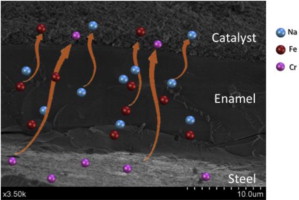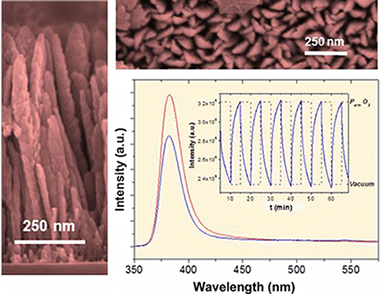Artículos SCI
2014
2014
Química de Superficies y Catálisis
Metallic structured catalysts: Influence of the substrate on the catalytic activity
Dominguez, MI; Perez, A; Centeno, MA; Odriozola, JAApplied Catalysis A-General, 478 (2014) 45-57
Show abstract ▽

In order to study the influence of the metallic substrate on the catalytic activity of structured micromonolithic catalysts, a CuOx/CeO2 catalyst was deposited on different oxidized or enameled metallic micromonoliths and tested in the PROX reaction under ideal and realistic conditions. The obtained results show as both activity and selectivity depend on the nature of the alloy and the nature of the interphase between the metal substrate and the catalyst layer. In oxidized micromonoliths, diffusion of Cr and Fe has been observed. For enameled micromonoliths, together with that diffusion, the interaction of the glass-ceramic interphase with the reactive gas streams resulted in the partial hydrolysis of this layer leading to diffusion toward the catalyst surface of the hydrolysis products, namely Na, Ca and Si cations. In some cases, the alteration of the surface composition favors the spreading of the copper active phase. As a result, it must be concluded that the metallic substrates are not spectators, at least in the PROX reaction, playing a fundamental role in the performances of the catalytic devices.
Mayo, 2014 | DOI: 10.1016/j.apcata.2014.03.028
Materiales y Procesos Catalíticos de Interés Ambiental y Energético
In situ XAS study of an improved natural phosphate catalyst for hydrogen production by reforming of methane
Abba, MO; Gonzalez-DelaCruz, VM; Colon, G; Sebti, S; Caballero, AApplied Catalysis B: Environmental, 150-151 (2014) 459-465
Show abstract ▽

Some nickel catalysts supported on natural phosphate (NP) have been tested for the dry methane reforming reaction. Although the original impregnated 15%Ni/NP catalyst has no activity at all, the modification of the support by mechano-chemical and/or acid treatment strongly improved the catalytic performance, yielding a series of very active and stable catalysts. The chemical and physical characterization by X-ray diffraction (XRD), temperature programmed reduction (TPR), in situ X-ray absorption spectroscopy (XAS) and other techniques have shown that these treatments mainly modify the interaction between the nickel phase and the support surface. The nickel ions occupy calcium position in the surface of the phosphate phase, which stabilizes and improves the dispersion of nickel species. The final reduced catalysts present a much better dispersed metallic phase interacting with the NP surface, which has been identified as responsible for the observed outstanding catalytic performances.
Mayo, 2014 | DOI: 10.1016/j.apcatb.2013.12.031
Nanotecnología en Superficies y Plasma
Osteoconductive Potential of Barrier NanoSiO(2) PLGA Membranes Functionalized by Plasma Enhanced Chemical Vapour Deposition
Terriza, A; Vilches-Perez, JI; de la Orden, E; Yubero, F; Gonzalez-Caballero, JL; Gonzalez-Elipe, AR; Vilches, J; Salido, MBioMed Research International, 2014 (2014) 253590
Show abstract ▽
The possibility of tailoring membrane surfaces with osteoconductive potential, in particular in biodegradable devices, to create modified biomaterials that stimulate osteoblast response should make them more suitable for clinical use, hopefully enhancing bone regeneration. Bioactive inorganic materials, such as silica, have been suggested to improve the bioactivity of synthetic biopolymers. An in vitro study on HOB human osteoblasts was performed to assess biocompatibility and bioactivity of SiO2 functionalized poly(lactide-co-glycolide) (PLGA) membranes, prior to clinical use. A 15 nm SiO2 layer was deposited by plasma enhanced chemical vapour deposition (PECVD), onto a resorbable PLGA membrane. Samples were characterized by X-ray photoelectron spectroscopy, atomic force microscopy, scanning electron microscopy, and infrared spectroscopy (FT-IR). HOB cells were seeded on sterilized test surfaces where cell morphology, spreading, actin cytoskeletal organization, and focal adhesion expression were assessed. As proved by the FT-IR analysis of samples, the deposition by PECVD of the SiO2 onto the PLGA membrane did not alter the composition and other characteristics of the organic membrane. A temporal and spatial reorganization of cytoskeleton and focal adhesions and morphological changes in response to SiO2 nanolayer were identified in our model. The novedous SiO2 deposition method is compatible with the standard sterilization protocols and reveals as a valuable tool to increase bioactivity of resorbable PLGA membranes.
Mayo, 2014 | DOI: 10.1155/2014/253590
Materiales de Diseño para la Energía y Medioambiente
Biomechanical properties of the tomato (Solanum lycopersicum) fruit cuticle during development are modulated by changes in the relative amounts of its components
Espana, L; Heredia-Guerrero, JA; Segado, P; Benitez, JJ; Heredia, A; Dominguez, ENew Phytologist, 202 (3) (2014) 790-802
Show abstract ▽

Keywords:
attenuated total reflectance–Fourier transform infrared (ATR-FTIR);biomechanics;cuticle;cutin;flavonoids;tomato (Solanum lycopersicum) fruit
Summary
- In this study, growth-dependent changes in the mechanical properties of the tomato (Solanum lycopersicum) cuticle during fruit development were investigated in two cultivars with different patterns of cuticle growth and accumulation.
- The mechanical properties were determined in uniaxial tensile tests using strips of isolated cuticles. Changes in the functional groups of the cuticle chemical components were analysed by attenuated total reflectance–Fourier transform infrared (ATR-FTIR).
- The early stages of fruit growth are characterized by an elastic cuticle, and viscoelastic behaviour only appeared at the beginning of cell enlargement. Changes in the cutin:polysaccharide ratio during development affected the strength required to achieve viscoelastic deformation. The increase in stiffness and decrease in extensibility during ripening, related to flavonoid accumulation, were accompanied by an increase in cutin depolymerization as a result of a reduction in the overall number of ester bonds.
- Quantitative changes in cuticle components influence the elastic/viscoelastic behaviour of the cuticle. The cutin:polysaccharide ratio modulates the stress required to permanently deform the cuticle and allow cell enlargement. Flavonoids stiffen the elastic phase and reduce permanent viscoelastic deformation. Ripening is accompanied by a chemical cleavage of cutin ester bonds. An infrared (IR) band related to phenolic accumulation can be used to monitor changes in the cutin esterification index.
Mayo, 2014 | DOI: 10.1111/nph.12727
Nanotecnología en Superficies y Plasma
Oxygen Optical Sensing in Gas and Liquids with Nanostructured ZnO Thin Films Based on Exciton Emission Detection
Sanchez-Valencia, JR; Alcaire, M; Romero-Gomez, P; Macias-Montero, M; Aparicio, FJ; Borras, A; Gonzalez-Elipe, AR; Barranco, AJournal of Physical Chemistry C, 118 (2014) 9852-9859
Show abstract ▽

Transparent nanocolumnar porous ZnO thin films have been prepared by plasma-enhanced chemical vapor deposition. By controlling the H-2/O-2 ratio in the plasma gas, the deposition conditions were optimized to obtain an intense exciton emission at around 381 nm and virtually no luminescence in the visible region associated with electronic states in the gap. The intensity of the exciton band varied significantly and reversibly with the partial pressure of oxygen in the environment. This behavior and its variations with temperature and water vapor sustain the use of these thin films as photonic sensors of oxygen. Further experiments in liquid water show that fluorescence intensity also varies with the amount of dissolved oxygen even for concentrations lower than 0.02 mg/L where commercial oxygen galvanic sensors show limited sensitivity. These results and the use of ZnO as photonic sensor of oxygen are discussed by assuming a classical mechanism involving the photoactivated adsorption of oxygen when this oxide is irradiated with UV light during its fluorescence interrogation.
Mayo, 2014 | DOI: 10.1021/jp5026027
- ‹ anterior
- 276 of 420
- siguiente ›














